Learn everything you need to know about how to make buckwheat flour, how to store it, and easy ways to use it in everyday gluten free recipes that are full of nutrients and flavor and perfect for every occasion!
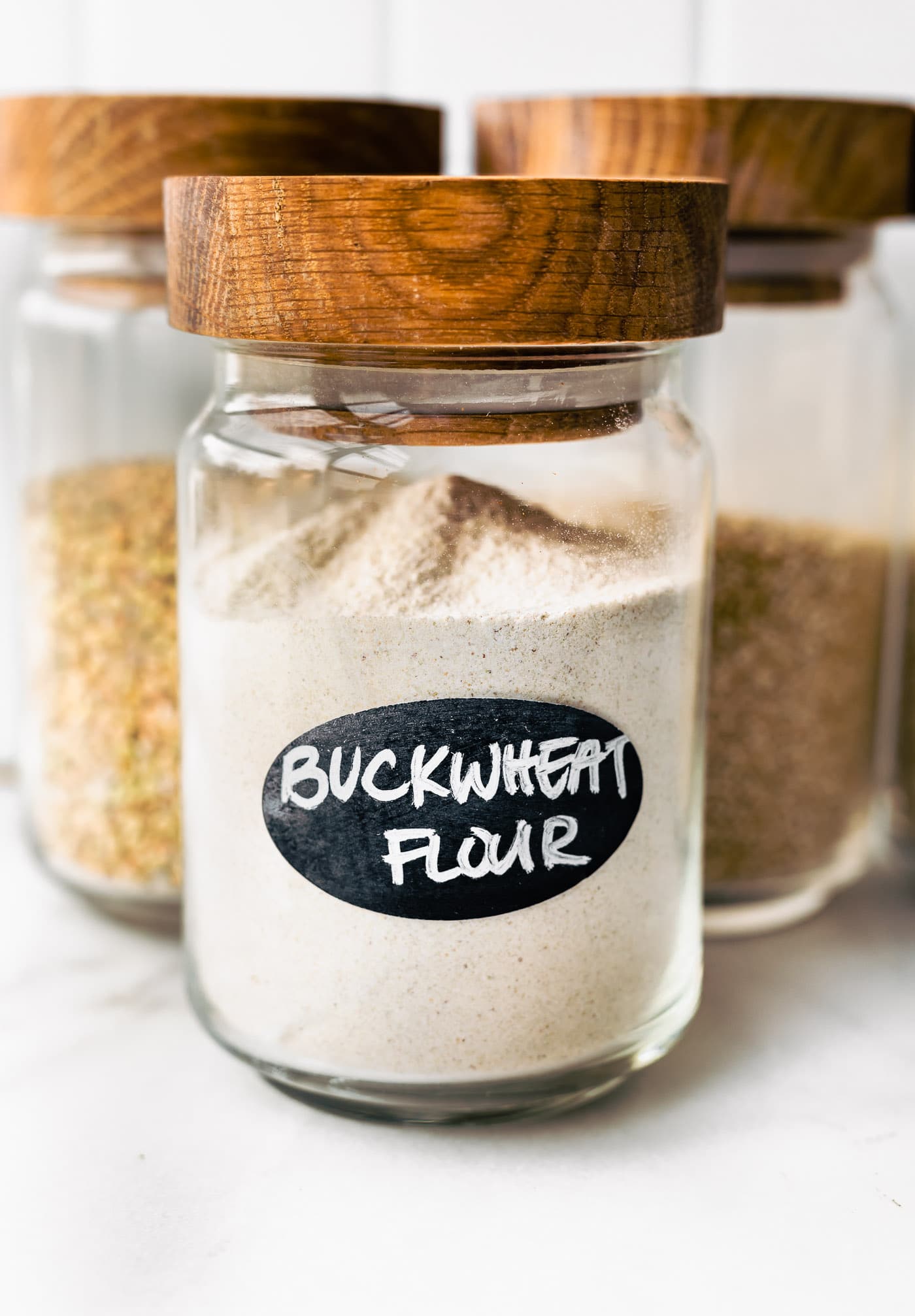
Part 3 of our Gluten Free Grains Month, this blog is part of our Buckwheat series in which we teach you what it is, how to use it, and more to spread knowledge about gluten free grains and help make it easier to follow a gluten free diet without missing out on delicious meals the whole family can enjoy!
Gluten Free Flour
We don’t know about you, but one of the biggest struggles we hear about from readers (and face ourselves) is finding gluten free flour alternatives that don’t make recipes taste strange or leave a weird texture.
Yet, through countless hours in the kitchen, we’ve discovered that the issue is not with the flours themselves necessarily but how they’re being used. You see, each gluten free flour substitute has its own nutritional value, flavor, and texture. They are not created equal and can be a bit high maintenance, requiring different measurements, liquid ratios, etc.
However, that doesn’t mean they’re bad and can’t be used! You just have to learn how to work with them. Luckily, we’ve already done the work for you. So, today, without further ado, we’ll be talking all about one of our team’s all-time favorite flour substitutes buckwheat flour! We’re even teaching you how to make it on your own!
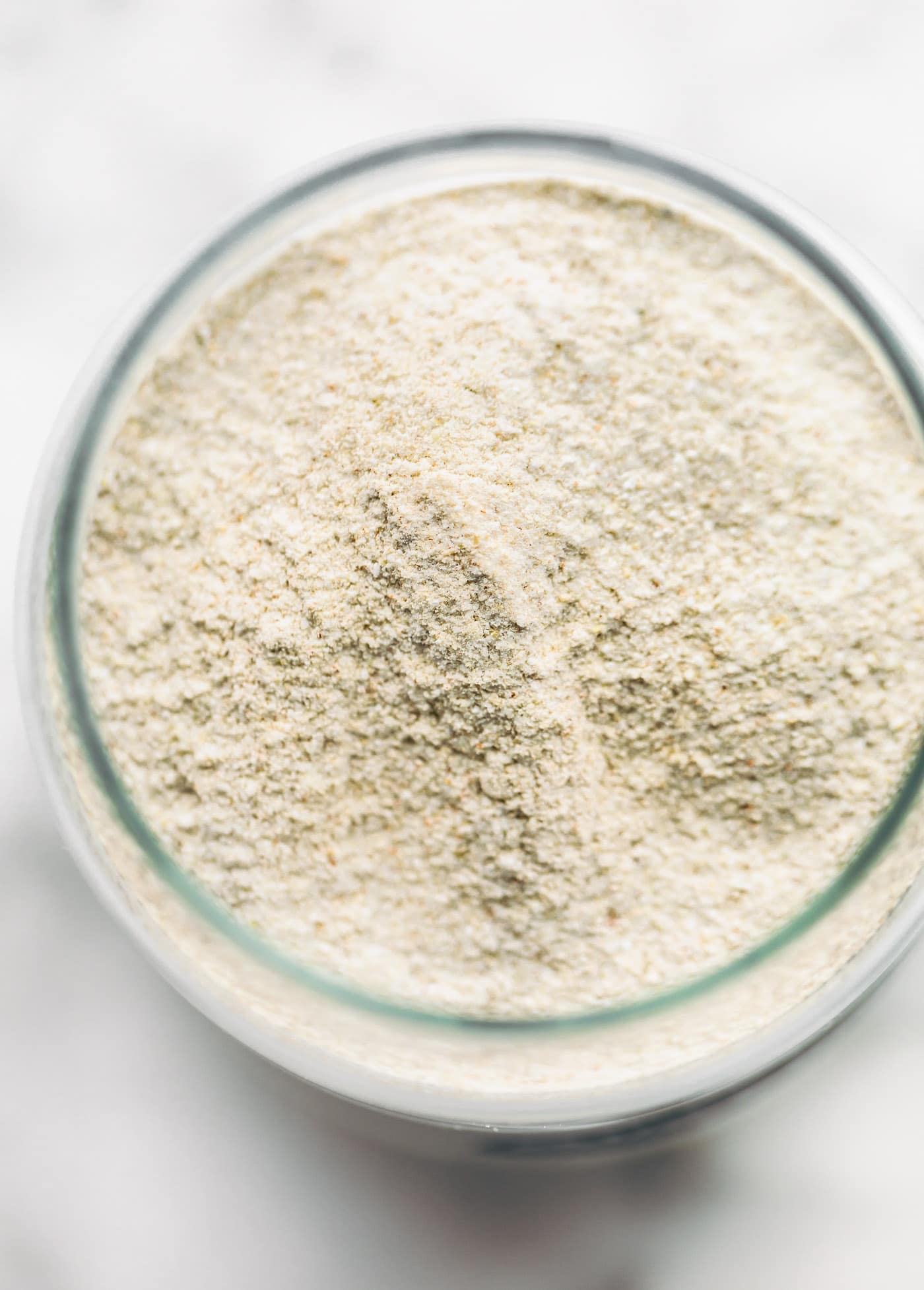
Promise, it’s super easy, incredibly budget-friendly, and honestly kind of fun to make. We’ll even give you a few recipes to get you started in the kitchen. After all, we aren’t doing all this hard work just to leave our buckwheat flour sitting on the counter are we? Heck no! Keep reading to find everything you’ll need to know.
What is Buckwheat Flour?
If you missed our buckwheat intro, be sure to check it out here. We break down what exactly buckwheat is, talk about its nutrient contents, health benefits, and more!
As the name suggests, buckwheat flour is made from the buckwheat plant. Considered a pseudo-grain, buckwheat is used in similar ways as grains would be, but it is not derived from a grass plant and contains no gluten. To make flour, whole buckwheat groats (the hulled seed of the buckwheat plant) are ground into a fine, flour-like consistency.
Nutrition Note: Unlike traditional refined flour, buckwheat flour provides a good source of protein, fiber, vitamins, and minerals, making it an especially great option for those who follow a plant-based diet.
Buckwheat Flour vs. Refined Flour
Refined Flour: Also referred to as all-purpose flour, refined flour is made from wheat grains that have undergone a process known as refining that removes the germ and bran from the whole grain. This leaves just the soft endosperm of the wheat plant. The endosperm is then often bleached to remove the brown color and create the white flour we’re used to seeing. As a result, refined flour offers virtually no nutritional benefits or fiber.
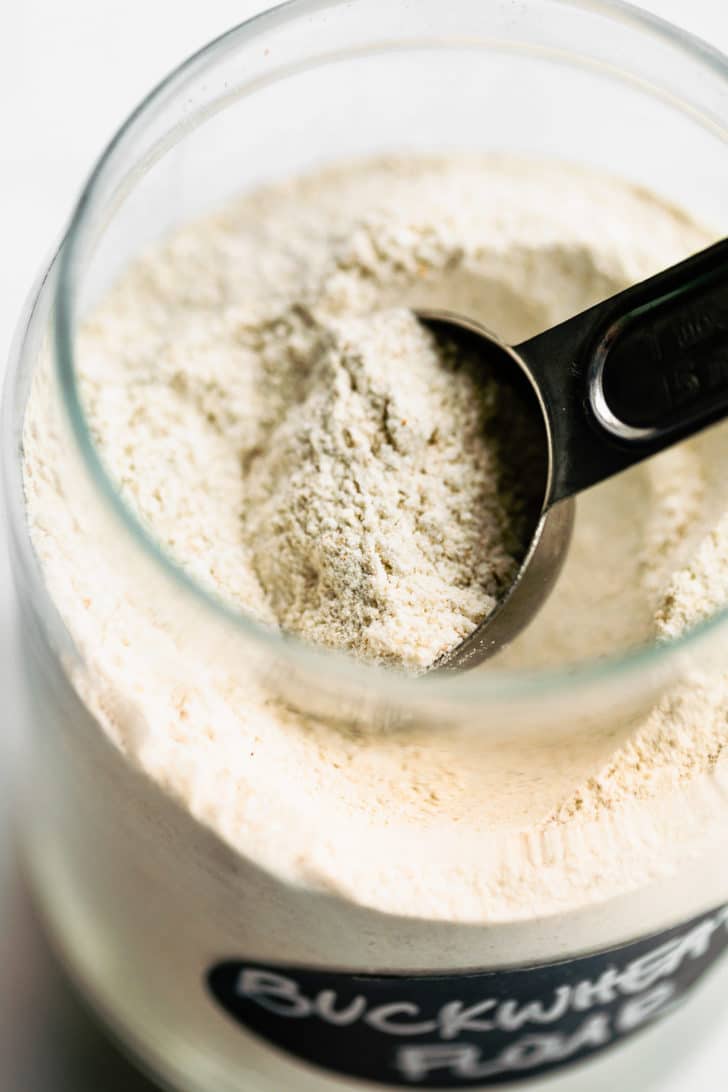
Buckwheat Flour: Unlike refined flour, buckwheat flour is made from whole grain. This means it retains the bran and germ which offer most of the nutritional benefits found in seeds. It is also not bleached and contains a brownish hue that is often speckled with darker flecks.
Note: In addition, whole grain flours like buckwheat contain natural oils that have not been stripped from the seed. As a result, they have a shorter shelf life than refined flour alternatives, but we’ll get into more details on that later in the post!
How to Make Buckwheat Flour (Gluten Free)
Learning how to make buckwheat flour couldn’t be easier! In fact, we’re willing to bet that once you try it for yourself you’ll never go back to store-bought versions again. Just follow the steps below!
- Place ⅔ to 1 cup of whole buckwheat groats in a food processor or high-speed blender.
- Pulse until a flour-like consistency is formed.
- Set the flour aside, and repeat steps one and two until all of your groats have been used.
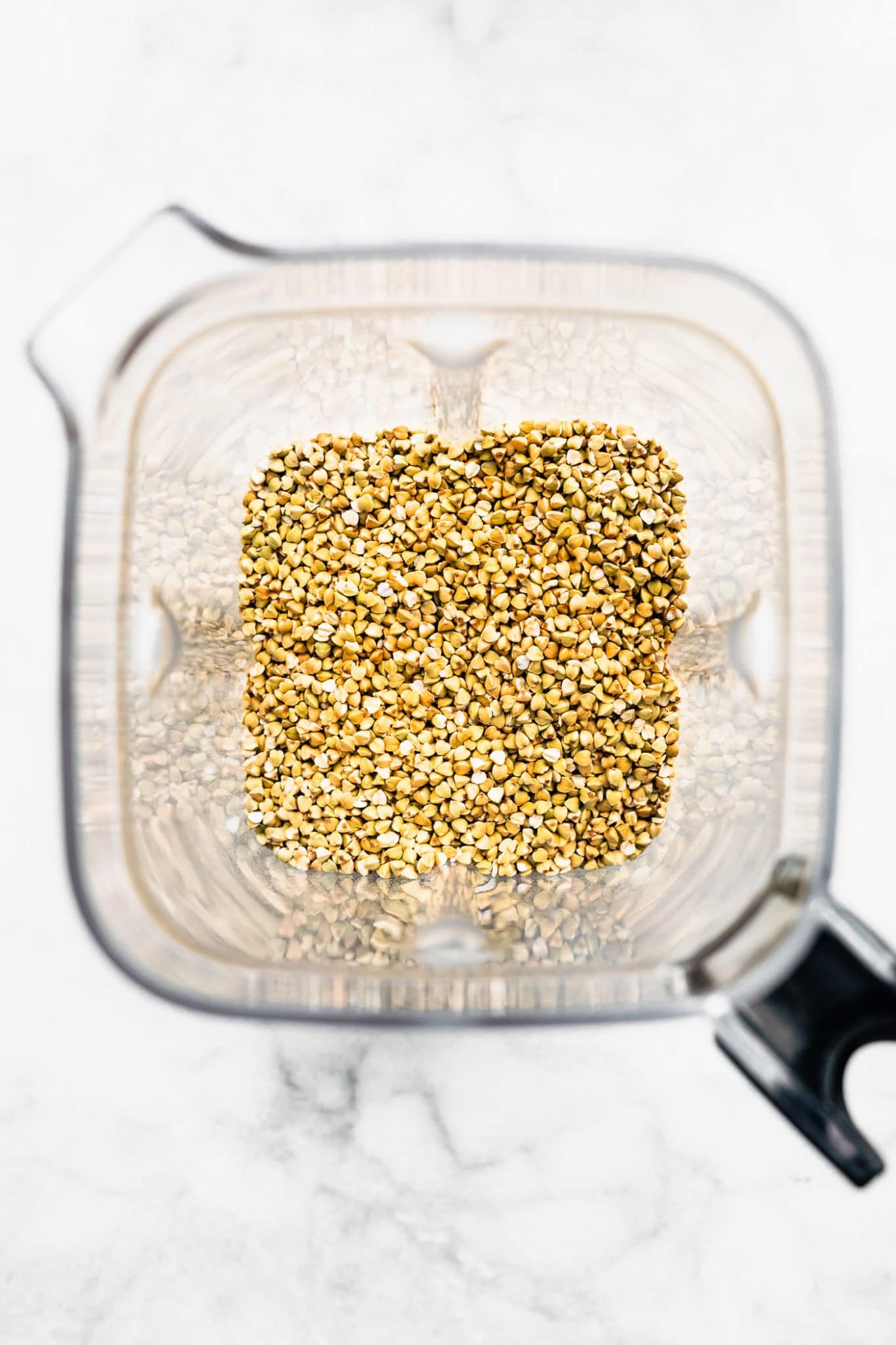
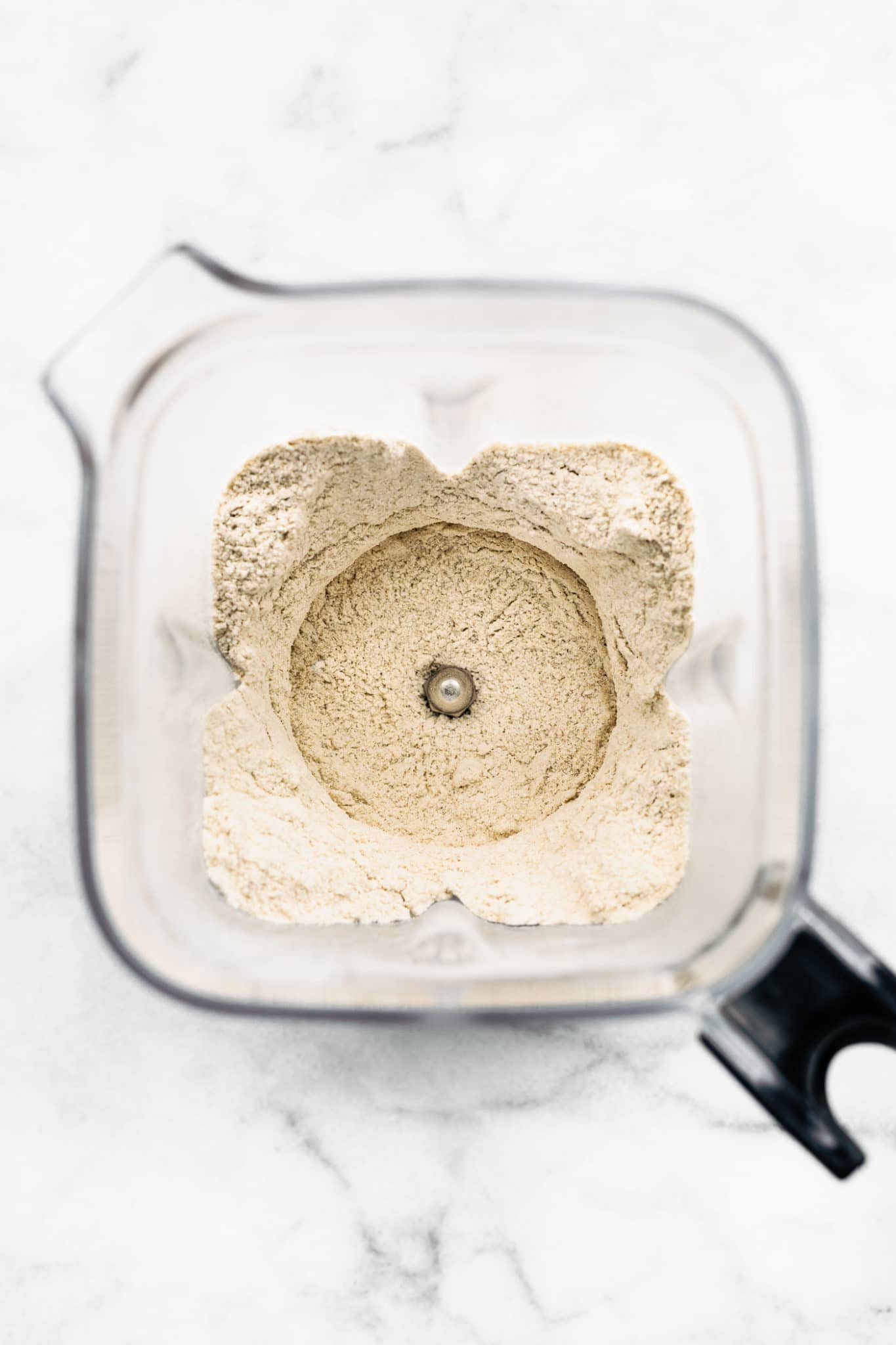
Pro-Tip: Your flour should be fine but not so fine it resembles sand!
Key Tips For Making Whole Grain Flour
We know we told you the process of making your own buckwheat flour is super simple, and it is! However, we’ve come up with a few tips to make the process even smoother.
Weigh Your Groats. For the most accurate flour measurements, weigh your whole groats and flour. 310 grams of whole groats should yield 309 grams of flour. If not, keep blending!
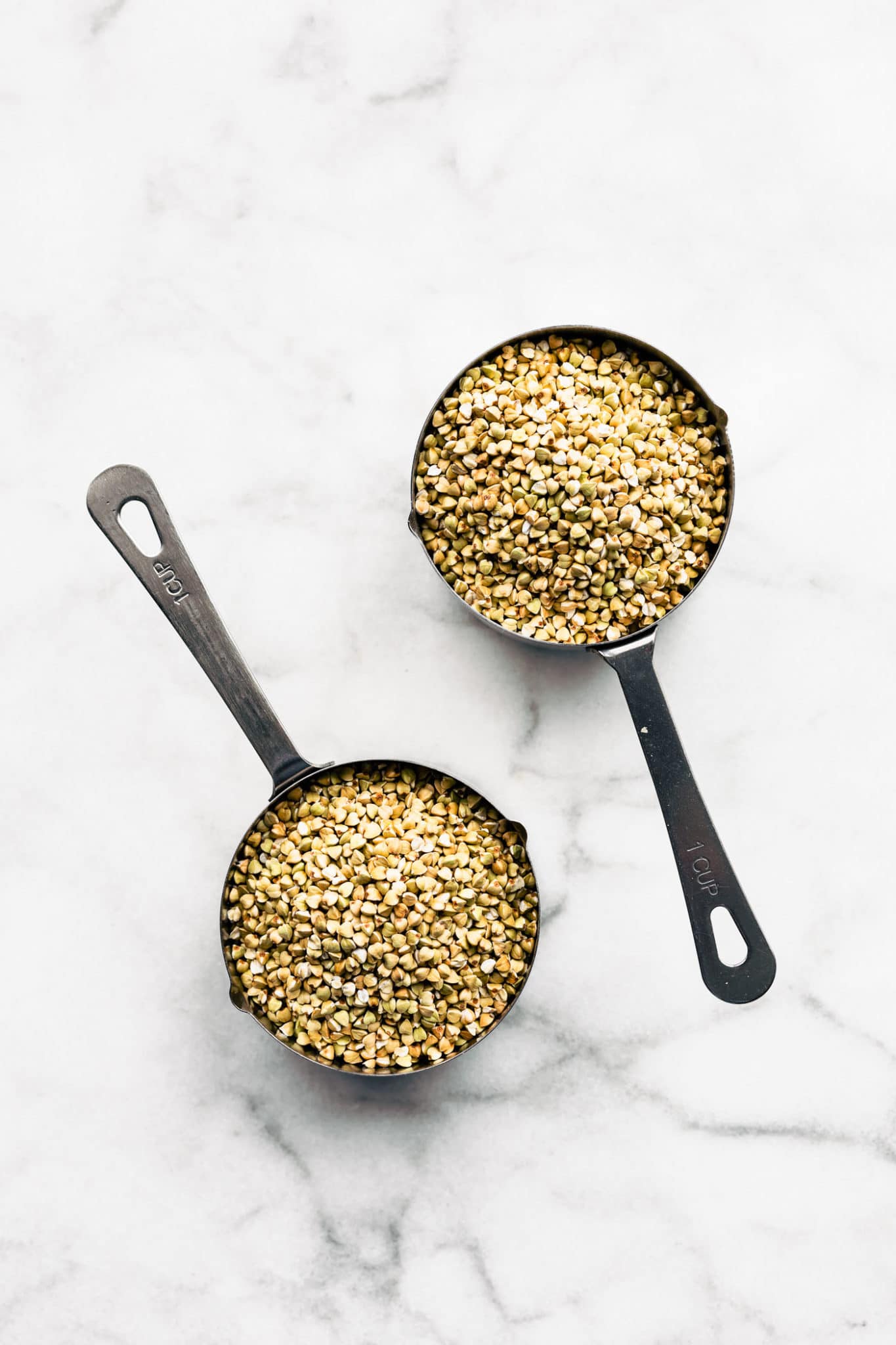
Note the Color. Depending on the type of groats you use, the color of your flour may vary. Most commonly, buckwheat is a white color with small brown spots. However, it can also turn into shades of light brown or pure white when blended. So, don’t panic if your flour looks different from the pictures!
How to Use It
The ways to use buckwheat flour are endless. We’re definitely always experimenting with it! However, common uses include soba noodles, pancakes, and breads. That being said, baking with buckwheat flour is not quite the same as baking with refined, all-purpose flour. Due to the fact that buckwheat doesn’t have the binding properties associated with gluten, baked goods made with it can often be crumbly or heavy.
When it comes to simple options like pancakes, waffles, and crepes that gain much of their structure from eggs, it’s typically safe to substitute the flour used with buckwheat flour in a 1:1 ratio.
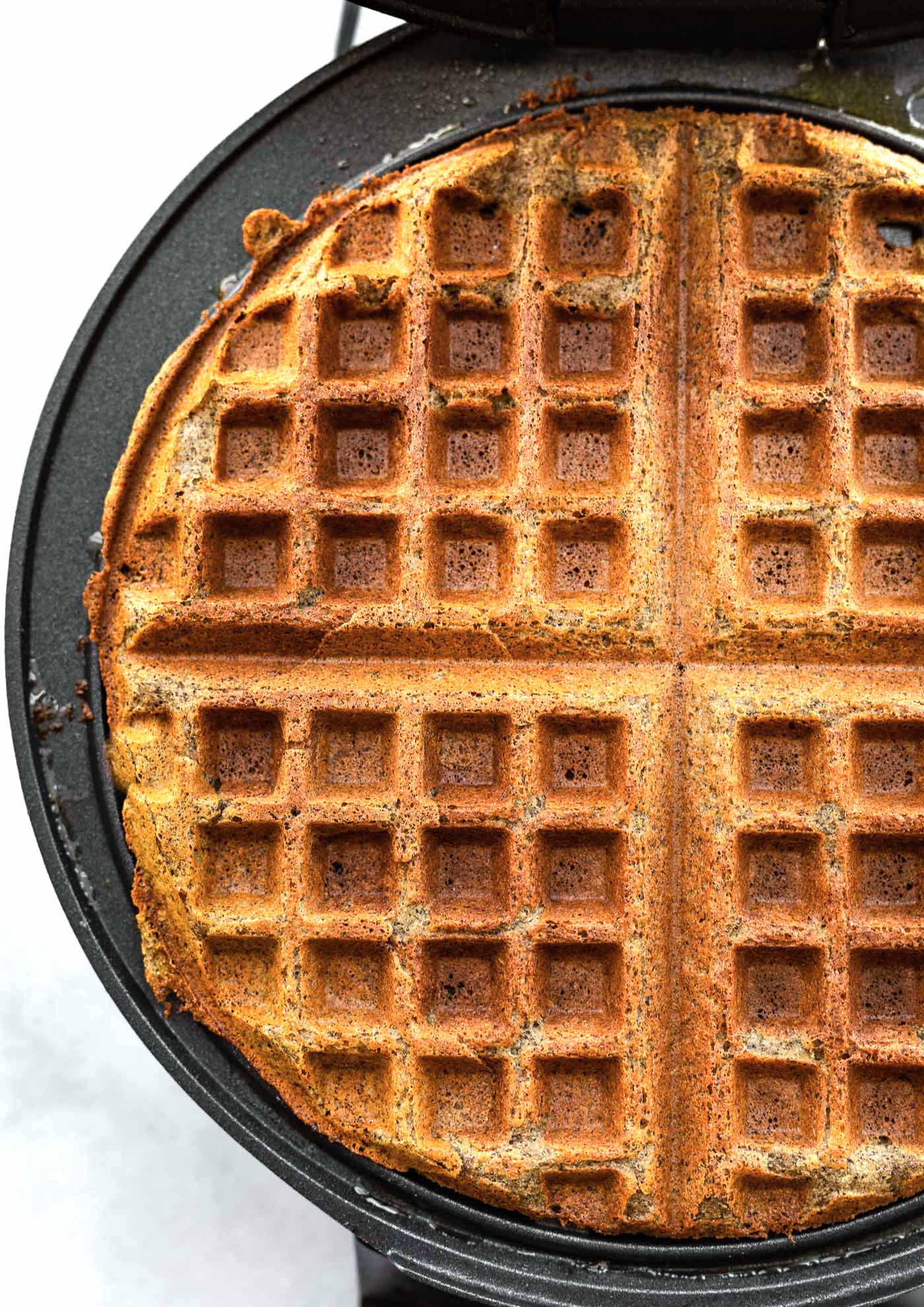
However, for other less structurally sound recipes, we highly recommend combining buckwheat flour with another mild flour such as rice flour to help provide integrity to your baked goods.
Substitutions for Buckwheat Flour
If you remember back to the nutrition components we discussed, buckwheat flour is super high in fiber. That means that it can’t always easily be substituted with other options.
For the best results, we recommend swapping out flours that have similar fiber contents. Our favorite options are listed below. Feel free to substitute any of the options with buckwheat flour in equal parts. Just keep in mind that the taste and texture of your recipe might alter slightly based on which flour you use.
- Oat Flour
- Sorghum Flour
- Quinoa Flour
- Chickpea Flour
- Brown Rice Flour
- Gluten Free All Purpose Flour
Storage Options
Due to the fact that whole grain flours like buckwheat contain natural oils, their shelf life is considerably shorter than refined flours. If exposed to the air, they oxidize fairly quickly. So, it’s important to keep your flour in an airtight container. Store it for 2-3 months at room temperature, in the fridge for up to 6 months, or in the freezer for up to 1 year!
Common Questions
Of course, the term healthy is relative and looks different for everyone. However, generally speaking, buckwheat flour offers more nutritional benefits than refined flour.
Buckwheat definitely has a unique flavor! Most commonly, it is described as having a nutty, earthy, slightly bitter flavor. When buckwheat groats are roasted or the flour is combined with others, the taste is tamed and much more mild than consuming buckwheat flour on its own.
Often used interchangeably, buckwheat and kasha are not the same things. In fact, kasha is made from buckwheat groats that have been roasted and is super easy to make on your own! We like to add it to soup, serve it as a side dish, or prepare it with sugar and milk for a cereal-inspired option!
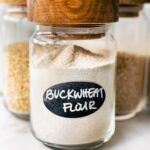
How to Make Buckwheat Flour
- Total Time: 5
- Yield: 1.5 to 2 cups flour 1x
- Diet: Gluten Free
Description
Learn how to make buckwheat flour for a homemade gluten free flour alternative that’s nutrient-rich and perfect for all your baking needs!
Ingredients
- 2 cups (310 grams) buckwheat groats
Instructions
-
Place ⅔-1 cup buckwheat groats in a high-speed blender or food processor at a time.
-
Blend or pulse until a fine flour-like consistency is formed. Around 45 seconds or so. Transfer the ground buckwheat flour to a glass jar or bowl.
-
Repeat with the remaining groats.
- Store in a glass jar or airtight container at room temperature for 2-3 months or the fridge for 6 months. Freeze up to 1 year.
Notes
Once processed, this recipe yields 309 grams of buckwheat flour. The buckwheat should be fine but not so fine it feels like sand.
2 cups of buckwheat groats will yield a little under 2 cups of buckwheat flour but may be slightly less depending on the power of the blender or food processor.
- Prep Time: 2
- Cook Time: n/a
- Category: baking
- Method: Blend
- Cuisine: American

Did you find this article helpful? Do you still have questions about buckwheat flour? Let us know in the comments below!
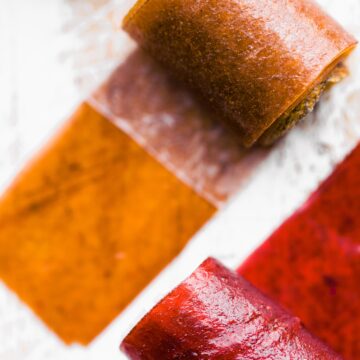
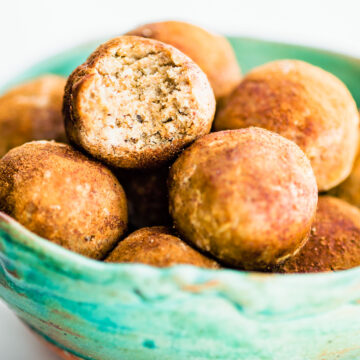
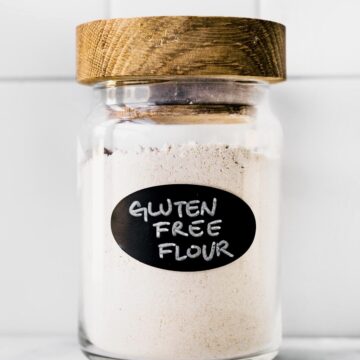
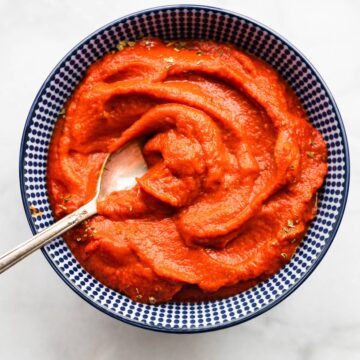


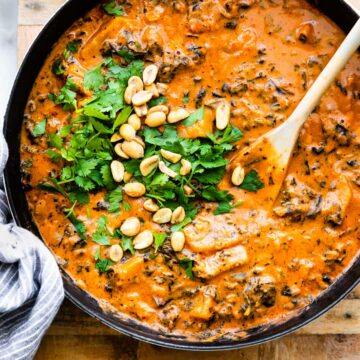
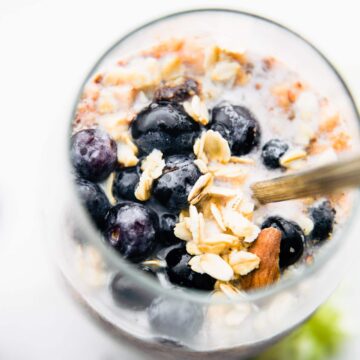
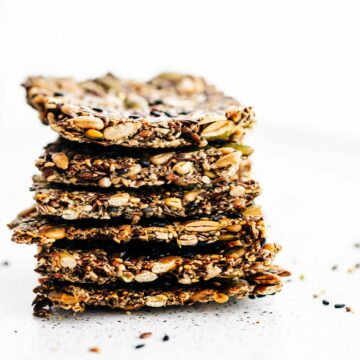
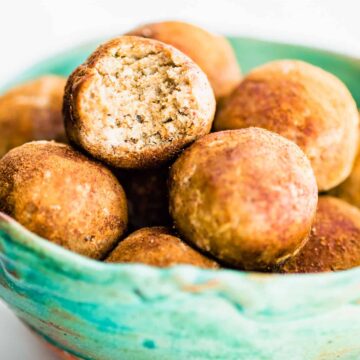
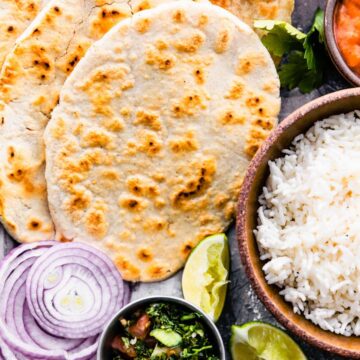
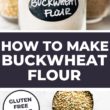
I made this for a waffle recipe and the waffles totally fell apart! Even though I sprayed the pan, the top half stuck to the top of the waffle iron and the bottom stuck to the bottom. I checked the recipe against some others to make sure it wasn’t just a bum recipe and it was the same proportions of ingredients. Any ideas as to why this may have happened?
Hi Anne! Sorry to hear that. Can you tell me what buckwheat waffle recipe you made? Was it ours or from another site?
VERY INFORMATIVE. I WAS PLANNING ON CHANGING TO BUCK WHEAT FLOUR . OF YR CHOOSES WHAT WOULD BLEND WELL MAKING BUCKWHEAT FLOUR LIKE ALL PURPOSE FLOUR .ALL SO I can’t use eggs ,will other things like tapioca work etc work well with buckwheat . I REALLY ENJOYED ALL THE EXTRA INFO SO THANK U VERY MUCH . PS HAD U THOUGHT OF USING A KITCHEN AID FLOUR MILL FOR GRINDING .WHAT U THINK.
Thanks, Steven! Yes, I think your KitchenAid grinder will work to make buckwheat flour. Keep me posted!
Is buckwheat a functional food, like blueberries are functional, in the world of functional medicine?
Does toasting the seeds denature the proteins or harm the other good/nutritional components of the grain? And, do the hulks have nutritional benefits? Is the hule akin to the shell of, say, a peanut?
Good question! I don’t think toasting the seeds denatures the protein, at least not very much, since it’s a light toast vs bake. And not for uncertain of the hull benefits. Eating raw hulls are not recommended, not edible by themselves. Definitely fact check me on that though!
Thank You for replying! 💖 That is so kind of you.
I did not realize that the hulls are hard, like that of a walnut. I have learned, now, that the hulls make excellent mulch.😅
My goal is to make a reliable sandwich bread and sourdough bread, from scratch. I want to make my own sourdough starter with just the flour and water.
Thank you, again!
Please excuse my typos.🫣 I meant hull and hull.
Hi! If I were to roast the buckwheat groats before making the flour how would I do that?
I would place the groats on a large rimmed baking sheet, then toast/bake in the oven at 350 F for about 15-20 minutes, shaking to mix the kernels halfway during cooking. They should look and smell a bit golden and nutty. Does that make sense? Be sure not to overcook, so keep an eye on them while baking.
Most recipes that I’ve seen using groats stress washing them thoroughly before use. Should the groats be rinsed and dehydrated before grinding? Thanks in advance!
It depends on where you buy them. Bulk section or pre packaged by a manufacturer. I buy buckwheat from bobs redmill, which doesn’t require stress washing. Similar to quinoa flour, you can find packaged quinoa pre-rinsed or not pre-rinsed. But overall, doesn’t hurt to wash, dry them out, then toast before making into flour. Does that make sense?
Yes it does. I’ll try some that are pre-packaged so perhaps I can keep the flour raw (it has better thickening properties that way). Thanks you!
Keep me posted!
Buckwheat was my favorite flour even before I became sensitive to gluten. Unfortunately, the bigger alternative grain mills – Bob’s and Arrowhead – are apparently including more hull material in their buckwheat flours. This forces them to pulverize the groats and gives the resulting product a gray to charcoal color. My once beautiful corn muffins looked like concrete. I have been making my own buckwheat flour for some time (with a coffee grinder) but may switch to your suggestion of the high-speed blender. Thanks for the great article.
Keep me posted! I love making my own. The color can vary depending on type of groats, correct. I also think roasting them helps.
Thanks for this recipe – I’m looking forward to trying it! I’ve only bought buckwheat groats, roasted them, and used them that size and texture. For buckwheat flour, do I just use the groats raw?
Hi Jane! Yes, you would use raw buckwheat groats. But if you want less of that earthy flavor, you could toast the groats like you’re making kasha first and then blend it once dried out. Does that make sense?
Huh. Sounds interesting! I’ll have to try it both ways and compare the flavor. I bought some buckwheat flour that was slightly greyish and have been using that to bake. Which way do you think that was made? Thanks!
What are you using it for? I like it a little less earthy so toasting is nice!
I’m using it to make brownies and cookies, mostly. I first had buckwheat flour cookies in Japan and they were so good that I’ve been playing around with buckwheat flour here (in California) to try to recreate them. I think the color of “buckwheat flour” in the US is different from in Japan and now I’m wondering if in Japan they toast the groats first. Thanks!
It very well could be! Do you recall where You got them in Japan ? A local store? Did they call it kasha flour?